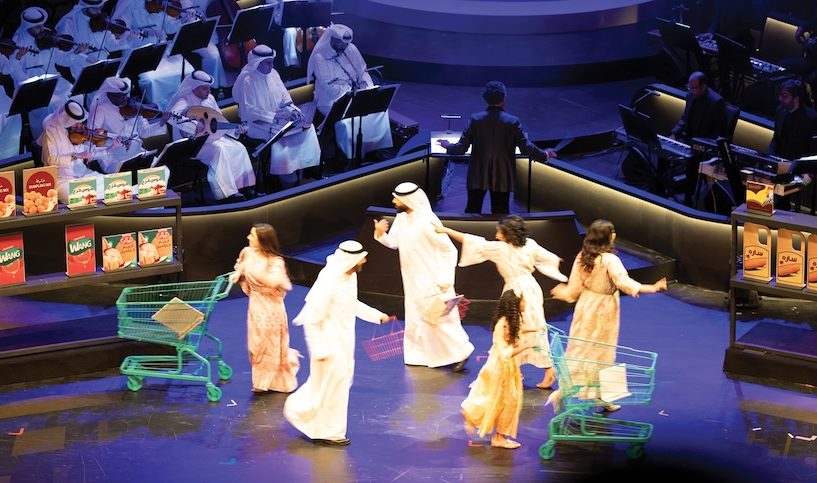by Yasmin Mostafa
Graish. Offstage; Intense rehearsals, 12 hour schedules and back to back production meetings. On stage; a rush of nostalgia and “warmth” at reliving selective childhood memories on Tv Screens, segments of narration, and interpretive art rolled into a series of beautiful performances on stage. A gripping development of pivotal scenes that take you on a journey within a journey of memories that touches hearts of all ages. The show develops through Thirty-four scenes against continuous transitions of beautiful sets on stage. Over the concert’s hour and a half, we follow the nostalgic ramadan memories from the 80s and 90s in the artist’s mind, Director Mr Fahad Al Rahmani.
Directed by Mr Fahad Al Rahmani and produced by the creative powerhouse that is Free Jabriya, the production features talented young performers that extend an immersive experience to audiences in Kuwait. In a very original approach, Free Jabriya invites you to their latest musical with a dress code. A Graish reception followed by the Graish show in an optional dress code, “Graish” attire, beautiful Ramadan Daraas and Dishdashas to convey they are not just an audience but a part of the show. Think of your ticket as an invitation to a warm reception and a community space followed by an entertaining show.
As much as you would think theatre is a lost art, Free jabriya proves you wrong. At a time when entertainment seekers wait for new Netflix releases, Free jabriya ensures their theatre work stays immensely relatable, touches several generations, and stays relevant to our times. They pledge to inform audiences on our culture, middle eastern legacies and heritage and aim to elevate Arabic performances to a more global scale by celebrating our nuances. This time, they depict those unique ramadan moments, amalgamated into an artwork that speaks unity, making us feel closer than ever because we share the same memories and practices.
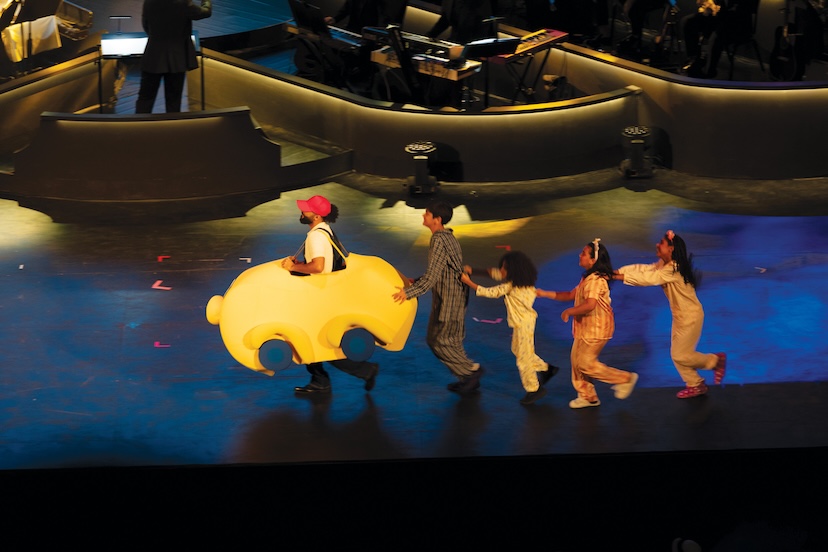
Mr. Fahad Al Rahmani’s passion for theatre and the stage started since childhood. It was last summer in Spain when he introduced the idea to the team at Free Jabriya. Despite the first meeting didn’t happen physically, the idea translated instantly, and it took the team twenty four hours to embrace and love the concept behind it. Fuelled by his vision, Mr Fahad Al Rahmani took to writing the show all summer and took it into his own hands to dissect it scene by scene to translate it to stage. He didn’t stop there, but also composed and wrote two original songs for the show. Having given previous lectures about leadership and management, he attests the loving team behind Free Jabriya, passionate people who love doing what they do, as must-win ingredients to a successful and creative environment and what encouraged him to keep giving to the show and believing in it more and more. It was the strong desire and hopes of allowing older audiences to reminisce of “Al Zaman Al Gameel”..a.k.a the good times. Art can unify us and Graish offers us just that, by providing an opportunity to re live our wonderful memories of the 90s and 80s. Younger audiences are invited to enjoy the dance, performances, and music even if they don’t get to recognize every historical television reference.
“We aim to deliver value-driven entertainment” says Maryam Al Khatrash, Creative producer at Free Jabriya, “ not a run of the mill performance to get a show together and sell tickets for business, but to provide an art. There is an intent behind every show, a memory or a certain emotion that audiences can walk away with.” She goes on to explain that at the base of everything they do is Joy, a major value for the team, and a wider sense of a community feeling. From previous experiences with successful productions, the likes of “Roo7 Al Sharq” “Rahbaniyat” and “Miami” they found the best vision for Mr Fahad and helped to visualize it more and develop it further for stage. “Coming out of the last Miami show, the new challenge for Graish was acting, together with performative dance, a new category of show which I was intrigued to learn from and see on our stage. We wanted our audiences to leave with more.” Says Maryam Al Khatrash.
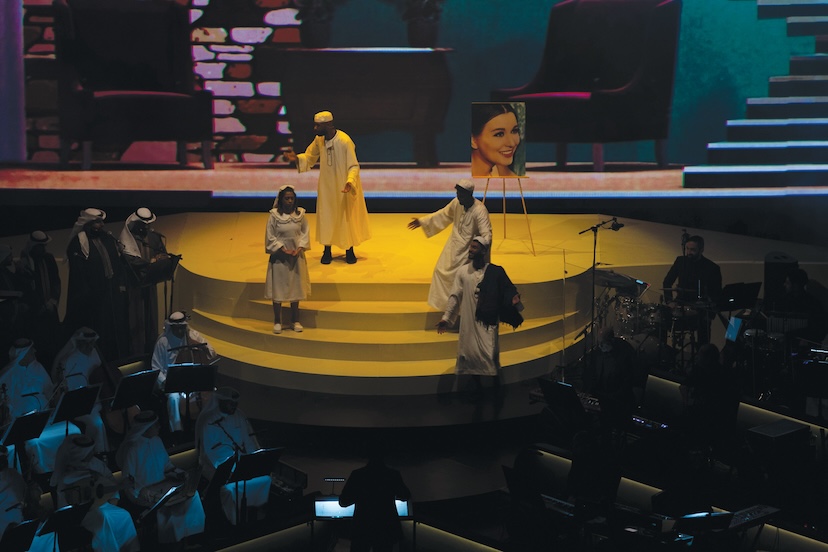
Apart from the rich layers and details to the scenes of the show there was a major culture element. “Focusing on regional talent to deliver Graish was important. We hired talented individuals who could relate to the message and voice of the Show. From stage design to song curation to Costume design and lighting, people working with us on the show understood the culture element to Graish” Says Zaina Ammouneh, Production Manager at Free Jabriya. She attests to the originality of the show to the new ways of experiencing the old, and re interpreting our memories.
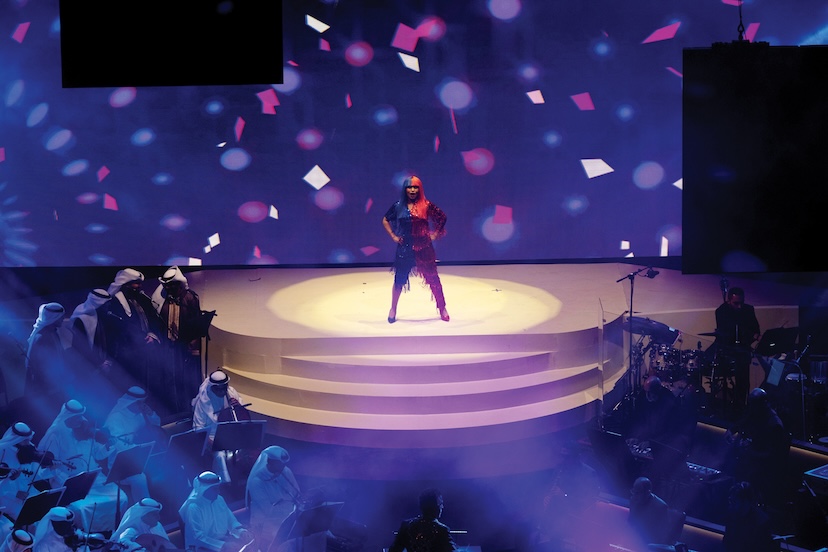
Over the play’s one hour and half long running show we follow two beautiful journeys taking place on stage. Echoing a Ramadan timeline, it begins with the first glimpses/sightings of the moon crescent that announces the entry of Ramadan, from the exquisite Graish, “the last supper” through gerge3an till Eid celebrations. Simultaenously the show also journeys through a typical day in Ramadan.
The show opens with the first act of “salo 3ala ahmad” song, a tribute to the early eighties shows. The female choir are decked out in traditional “thoubs”, Arabic gowns with intricate goldwork and embellishments, and male choirs in “Bishts”, embellished male gowns on top of their formal dishdashas. The show transitions to the hustle and bustle of a very busy night, the night before the first day of Ramadan. An insanely busy COOP/Supermarket set comes up on stage with frantic mothers and families stocking up and shopping for essential commodities of Ramadan. The Props and visuals on screen behind re inforce our beloved Kuwaiti brands in ramadan. The show then transitions to a very popular scene and re enactment of “el 3eyal kebret” a widely known Egyptian comical play in 1979 for which many television networks have provided hundreds of re runs to garner love and laughs from more than two generations. We find our performers leaving behind their Kuwaiti heritage garments and get into the signature Egyptian nightgowns and robes of the play. What was stunning was the true to form re enactment of the Egyptian performer “Younes Shalaby” in his copy of his Egyptian robe, his acting and a close resemblance to his singing voice.
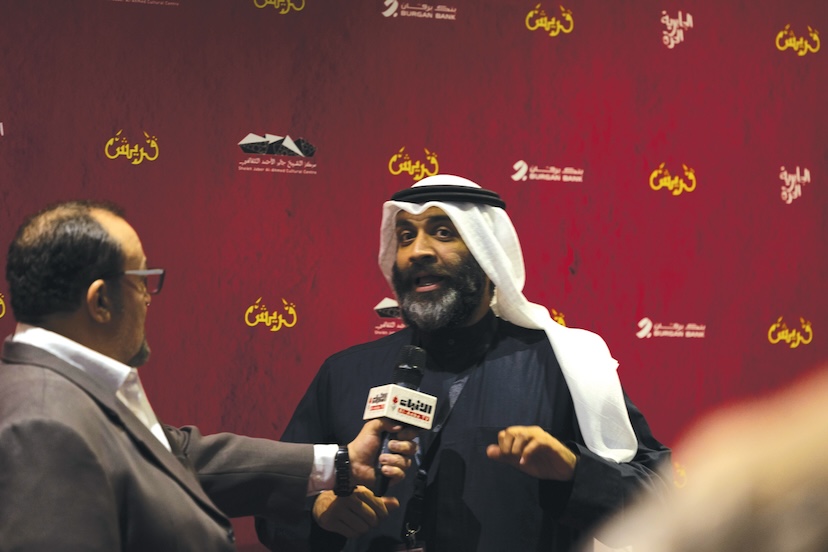
The next scene is another rush of nostalgic memories of early mornings in our grandmas bedrooms or living rooms. A rush of our beloved Arabic cartoon characters come out of the big TV Screen on stage and engulf the kids performers. Sebastien, Jazoora and Jongar bring back so many nostalgic memories. Next comes a scene, drawing inspiration from popular Kuwaiti Drama Series in the early 2000s “Al Qarar Al Akheer” and “Droob Al Shak”. Drama series remain synonymous with Ramadan and a tool which glues families together. Performers take to the stage looking like characters straight out of both Drama series.
The story of Graish continues to spin seamlessly from scene to scene unfolding from “ fawazeer” characters sherihan and Fatoota to more drama kuwaiti series to Badr Al Zaman an iconic historical show, to Gerge3an and many more. The unfolding happens in different time periods or eras bridging Arabic characters and themes in a compelling and swift artistry and fashion.
Storytelling is nothing without costume development. “Costume is an integral part of character development and storytelling”, says Adel Al Asaad, lead Costume Designer and director for Hair and Make-up for the show. To build on transformations throughout the show’s many scenes, finer details of dress styles, and aesthetics from different time periods had to be considered. Many of the show’s costumes and fabrics were sourced and adapted to stage locally and from Istanbul. Adel’s favorite time period in the show to work with was the 80s. “There’s a lot of sharp silhouettes like big shoulders and mix of fabrics and dramatic cuts and lengths that can be played with and invoke heavy nostalgia for the show and makes you fully re live the characters on stage.”

Stroytelling is further re inforced on stage. Two elements set the Graish stage apart from others. A big television screen to reinforce our imagination and memories with playbacks of original shows from the eighties and nineties and an elevated platform where star performers/key characters are shed light on. Apart from that, different sets had to be built for the different scenes. Architect by degree and a true activist at heart, Mohammed Al Mulla who started stage designing for Free Jabriya on Rahbinyat and Roo7 al Sharq pushed his boundaries further with Graish to meet the challenges of the show’s fast pace and multitude of scenes. He says Graish his most challenging show yet to design that many sets for all those scene, but the love and trust he received from Free Jabriya made him enjoy the process very much. “Theatre is one form of art to communicate ideas through. With time I started seeing things with the artists’ eyes, being in their world, relating to them and believing more in their idea to translate it to my sketches” He says.
The four days of the show sells out in a week. Audiences remembered, re lived, laughed and enjoyed and loved the performers and their performances. Everyone who worked on the show felt very sad to close the show and bring their journey to an end. Though Graish is considered a timeless show, taking the time tunnel is sometimes necessary to go back to our inner child and understand our journey in life all over again. It was a beautiful Graish, a beautiful journey. Well done Free Jabriya. You did it again.

